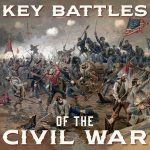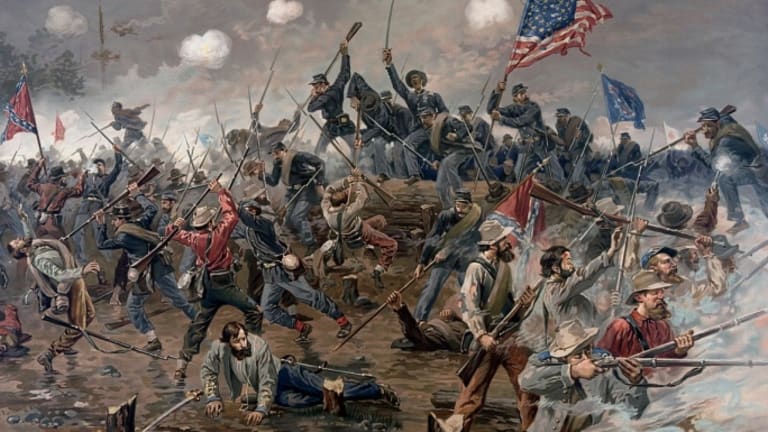It’s 1864. Lincoln is re-elected, and Sherman’s March to the Sea obliterated the Confederacy’s industrial base. But work remains for General Grant. He must contend with his greatest foe, Robert E. Lee. Now that Grant was directing the operations of the Army of the Potomac, Northern expectations were high. Southern expectations were also high.
Review: Grant’s Plan for Ending the War
- Grant came up with a 5-part strategy:
- Nathaniel Banks would march on Mobile, take it, then move eastward toward Georgia. There were no significant Confederate areas in
- Sherman, whom Grant put in charge of all western armies, would march toward and take Atlanta. Johnston stood in Sherman’s way.
- The Army of the Potomac would attack Lee’s army, forcing him back toward Richmond and preventing him from reinforcing Johnston.
- Benjamin Butler, now on the Peninsula and in command of the Army of the James, would march up toward Richmond from the southeast.
- Franz Sigel, who had an army of 6500 in West VA, would march into the Shenandoah Valley, commandeer its resources, and disrupt communications with the valley and Lee’s army.
- Regarding Butler and Sigel, Lincoln said “those not skinning can hold a leg.”
- Banks never even launched the attack on Mobile. Instead he moved up the Red River in an attempt to invade Texas. This effort failed.
- Butler moved extremely slowly up the Virginia Peninsula. He moved so slowly that the Confederates were able to put together an army of 18,000 under Beauregard. This army defeated Butler at the Battle of Drewry’s Bluff on May 15. Butler entrenched, and Beauregard did likewise. Grant later said Butler’s army was “as completely shut off from further operations directly against Richmond as if it had been in a bottle strongly corked.” Beauregard was able to send reinforcements to Lee.
- In the Valley, Sigel was opposed by an army under John C. Breckinridge. The two forced clashed on May 15 at the battle of New Market. Sigel retreats northward and is out of the campaign.
Grant Marches South
- Now that Grant was directing the operations of the Army of the Potomac, Northern expectations were high. Southern expectations were also high.
- Grant had three objectives:
- Tie Lee down (Grant told Meade “Wherever Lee goes you will go also.”)
- Bleed Lee’s army as much as possible
- Take Richmond.
- Lee’s goal (indeed, all he could hope for) was to block Grant and hold off as long as possible until the Northern will to fight was exhausted. Lee’s army was MUCH smaller than Grant’s and was operating on very low rations.
- Grant had over 120,000 men, while Lee had only 60,000.
- Grant ordered the army to march toward Lee. On May 4, the Union army crossed the Rapidan River. Grant was trying to get around the Confederate right flank.
The Wilderness
- Grant’s army camped at the old Chancellorsville battlefield. Torrential rains had washed open many of the shallow graves, leaving skeletons exposed.
- Fighting broke out on May 5 between parts of the two armies on the Confederate right (north).
- The Wilderness was so thick that control of the armies was very difficult. Smoke filled the battlefield, which was already filled with trees of all sizes. There were several “Friendly Fire” incidents.
- More fighting broke out on the Confederate left (south)
- Each side gave some ground, and each side lost some by the end of the day. Fighting stopped at the evening.
- On the morning of the 6th, Winfield Scott Hancock’s corps smashed the part of the Confederate line that he faced. Lee rode out to the front to personally rally the troops. A group of Texas soldiers grabbed Lee’s reigns and “ordered” him to the rear.
- Just as the Confederate line was about to collapse, Longstreet’s Corps arrived. They stabilized the line and even pushed the Federals back. Fighting again ceased in the evening.
- Many fires had been set by artillery shells. Several wounded soldiers, caught in the area of the fires, were unable to get away and burned to death.
- The Federals suffered about 17,500 casualties, while Lee lost about 12,000 (the same as at Chancellorsville a year before). This was about 1/6 of each army. It was the third-bloodiest battle of the war in terms of total casualties.
- James Longstreet was shot by some of his own troops and seriously wounded (but he does not die but would be out for months).
- The battle was a slight tactical victory for Lee, but Grant refused to retreat. Instead, he moved around Lee’s right toward Spotsylvania Court House. The Union soldiers cheered when they realized they were moving toward Richmond and not retreating.
- Lee moved as well to keep his army in between Grant and Richmond. Parts of his army reached Spotsylvania CH first (some literally running to beat the Federals) and started entrenching.
Spotsylvania Court House
- On May 8, parts of the two armies collided without much effect. That evening, the two armies began to entrench.
- The next morning, Gen. John Sedgwick, one of Grant’s corps commanders, was inspecting his Corps’ line. Some of his officers warned him to be careful, but he replied “they couldn’t hit an elephant at this distance.” Immediately after this, he was shot through the head by a Confederate sharpshooter’s bullet and died instantly.
- Lee’s line had a weakness, a big salient (the “Mule Shoe”) that bulged out during the Federals. On the 10th, Union soldiers broke a hole in the salient.
- The next day, Union troops moved up, and the day after that (the 12th), 20,000 troops under Hancock overran the Mule Shoe, but the Confederates regained control. The worst close combat of the war took place. Much hand-to-hand fighting occurred.
- One part of the salient became known as the “Bloody Angle”
- The firing was so intense that several trees (including a 22” oak) were cut down merely by musket and artillery fire.
- The fighting continued for the next several days. On the 21st, Grant disengaged.
- The Federals had another 18,000 casualties, and the Confederates lost 13,000. The battle was another draw.
- Meanwhile, Philip Sheridan led a cavalry raid down to Richmond. He encountered a Rebel detachment under Jeb Stuart. Sheridan’s and Stuart’s forces fought at the Battle of Yellow Tavern on May 11. Stuart was mortally wounded and died the next day.
- Grant wrote Lincoln a letter saying “I propose to fight it out on this line if it takes all summer.”
North Anna and Cold Harbor
- By late May, Grant’s and Lee’s armies were exhausted. For nearly a month, the two armies had been fighting almost continuously (this was a new thing).
- Since May 5, there had been 24,000 Confederate and 36,000 Union casualties. Both sides were getting replacement soldiers, but the new soldiers were not of the same quality as the ones they replaced.
- On May 23, Grant once again tried to move his army around Lee’s right flank and to place his army between Lee and Richmond.
- Lee anticipated Grant’s action and placed his army behind the North Anna River. Lee’s army was deployed in an inverted “V.” Grant deployed his army in a very awkward formation.
- Lee became seriously ill and was confined to his bed. Lee didn’t have any subordinates whom he fully trusted, so he wasn’t able to plan and order an attack on Grant
- By the end of May, the two armies were positioned very close to the Seven Days’ Battles and very close to Richmond. The Confederate line was 6 miles long and anchored on both sides by rivers. Both armies dug in.
- Grant decided to launch a major assault at the Confederates at Cold Harbor. He wanted to keep Lee’s attention and keep him from sending troops to the Valley or elsewhere. He was also frustrated by his inability thus far to crush Lee. He felt Lee’s army was heavily weakened.
- Many of the Union soldiers knew there was a good chance they might not survive the attack. A large number wrote their names and addresses on slips of paper and pinned them to their uniforms so that their bodies could be identified after the battle. One soldier wrote in his diary “June 3. I was killed” (his diary was found on his body at the end of the day).
- Skirmishing occurred on June 1-2. Then on June 3, Grant ordered 50,000 soldiers to attack 30,000 heavily entrenched Confederates. The attacks were easily repulsed. In the three days, Grant lost 12,500 men to only 1500 Confederates. Grant later admitted that he wished he had not ordered this attack (only thing he admitted that he had done wrong).
- The Northern public became disenchanted with Grant. Many newspapers (especially Democratic ones) called Grant “The Butcher.” (They disregarded what Grant had done in the West and the fact that he was wearing Lee down).
- Lee, on the other hand, realized what Grant was doing…bleeding his army to death and pushing him back toward Richmond.
To Petersburg
- Grant disengaged and moved the army across the James River in a wide turning movement. Union army made an immense pontoon bridge. Petersburg (25 miles south of Richmond) was his aim.
- Lee was surprised, but despite this the Union corps commanders in charge of taking Petersburg failed to push into the city (June 15-18). Lee rushed troops to Petersburg, and by the 18th. The Federals lost 11,000 during these few days, while the Confederates lost only about 5500.
- Lee’s army constructed an intricate set of trenches.
- Morale among the Federals began to decline. One regiment refused to attack the trenches when ordered to do so. When a newer regiment started to, the veterans yelled “Lie down, you damned fools! You can’t take them works!” They attacked anyway and lost 75% of their men.
- In the time since May 5, Grant had averaged more than 2000 per day (60,000 total). Lee averaged 1000 per day (30,000 total). This is essentially a “First Manassas every day.”
- In addition, many Union soldiers’ terms of enlistment had run out, and they went home.
- Northern morale plummeted. Opposition to Lincoln’s reelection rose to an all-time high.
 Would you like to learn the complete history of the Civil War? Click here for our podcast series Key Battles of the Civil War
Would you like to learn the complete history of the Civil War? Click here for our podcast series Key Battles of the Civil War
Cite This Article
"The Overland Campaign" History on the Net© 2000-2024, Salem Media.
April 18, 2024 <https://www.historyonthenet.com/history-civil-war-10-battles-part-18-overland-campaign>
More Citation Information.






